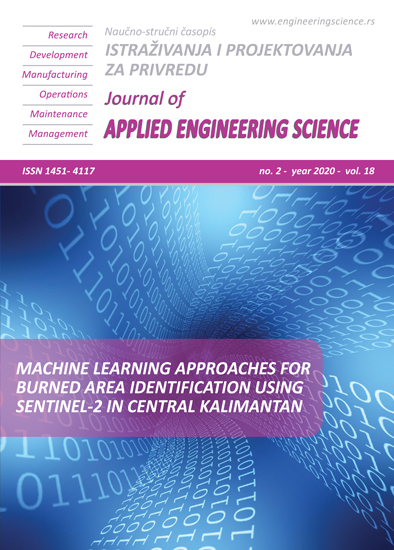BIOETHANOL PRODUCTION FROM SUGARCANE BAGASSE PRETREATED BY TRICHODERMA VIRIDE
Abstract
Preservation of fossil fuels are currently depleting with the massive exploitation of fuels. In this condition, breakthroughs are necessary to produce alternative fuels. One of the breakthroughs is bioethanol. It is a renewable energy which is more effective than gasoline inasmuch it can increase combustion efficiency and reduce exhaust emissions. In this work, a bioethanol process was done by using sugarcane bagasse waste material which has a lot of lignin and cellulose content. The content was converted into bioethanol by utilizing a strong base to degrade lignin and T. Viride as cellulose-producing and S. cereviseae yeast as a sugar converter to bioethanol. This present research aims to find the best formula of bioethanol production based on sugarcane bagasse with variations in cellulose hydrolysis temperature, shaking speed, and fermentation time by using an integrated shaker machine fuzzy-logic control of temperature and humidity. This research employed a complete randomized design experimental research (CRD) to test temperature, speed, and time modification by using a shaker machine. The independent variables were : (1) temperature, (2) shaking speed, and (3) fermentation time. The dependent variables measured were reducing sugar and bioethanol levels. The results showed that the best formula for producing bioethanol levels was at a treatment temperature of 45℃ and a speed of 140 rpm with fermentation time of 48 hours which resulted in a bioethanol level of 2.75%.
References
2. Sulfahri, M. Amin, S. B. Sumitro, and M. Saptasari, “Bioethanol production from algae Spirogyra hyalina using Zymomonas mobilis,” Biofuels, vol. 7, no. 6, 2016.
3. W. Chen et al., “Journal of the Taiwan Institute of Chemical Engineers Producing bioethanol from pretreated-wood dust by simultaneous saccharification and co-fermentation process,” vol. 79, pp. 43–48, 2017.
4. Y. S. Pradana, M. Hartono, L. Prasakti, and A. Budiman, “Effect of calcium and magnesium catalyst on pyrolysis kinetic of Indonesian sugarcane bagasse for biofuel production,” Energy Procedia, vol. 158, pp. 431–439, 2019.
5. A. de Araujo Guilherme, P. V. F. Dantas, C. E. de A. Padilha, E. S. dos Santos, and G. R. de Macedo, “Ethanol production from sugarcane bagasse: Use of different fermentation strategies to enhance an environmental-friendly process,” J. Environ. Manage., vol. 234, no. August, pp. 44–51, 2019.
6. W. Chen, S. Ye, and H. Sheen, “Hydrolysis characteristics of sugarcane bagasse pretreated by dilute acid solution in a microwave irradiation environment,” Appl. Energy, vol. 93, pp. 237–244, 2012.
7. S. Delabona, C. Sanchez, M. Ribeiro, S. Freitas, and J. Geraldo, “Bioresource Technology Use of a new Trichoderma harzianum strain isolated from the Amazon rainforest with pretreated sugar cane bagasse for on-site cellulase production,” Bioresour. Technol., vol. 107, pp. 517–521, 2012.
8. S. Lee, M. Kim, S. Kim, C. Hong, S. Ryu, and I. Choi, “Transcriptomic analysis of the white rot fungus Polyporus brumalis provides insight into sesquiterpene biosynthesis,” vol. 182, pp. 141–149, 2016.
9. A. Carolina et al., “Biocatalysis and Agricultural Biotechnology Catalytic properties of xylanases produced by Trichoderma piluliferum and Trichoderma viride and their application as additives in bovine feeding,” vol. 19, no. May, 2019.
10. L. S. Copete-pertuz, F. Alandete-novoa, J. Plácido, G. A. Correa-londoño, and A. L. Mora-martínez, “Science of the Total Environment Enhancement of ligninolytic enzymes production and decolourising activity in Leptosphaerulina sp . by co – cultivation with Trichoderma viride and Aspergillus terreus,” Sci. Total Environ., vol. 646, pp. 1536–1545, 2019.
11. S. Haghighi, A. Hossein, and M. Tabatabaei, “Lignocellulosic biomass to bioethanol , a comprehensive review with a focus on pretreatment,” vol. 27, pp. 77–93, 2013.
12. P. Pongcharoen, J. Chawneua, and W. Tawong, “High temperature alcoholic fermentation by new thermotolerant yeast strains Pichia kudriavzevii isolated from sugarcane field soil,” Agric. Nat. Resour., vol. 52, no. 6, pp. 511–518, 2018.
13. S. Tian, R. Zhao, and Z. Chen, “Review of the pretreatment and bioconversion of lignocellulosic biomass from wheat straw materials,” Renew. Sustain. Energy Rev., vol. 91, no. November 2017, pp. 483–489, 2018.
14. A. Waheed et al., “Insight into progress in pre-treatment of lignocellulosic biomass,” Energy, vol. 122, pp. 724–745, 2017.
15. C. J. Chuck, H. J. Parker, R. W. Jenkins, and J. Donnelly, “Bioresource Technology Renewable biofuel additives from the ozonolysis of lignin,” Bioresour. Technol., vol. 143, pp. 549–554, 2013.
16. G. Jahnavi, G. S. Prashanthi, K. Sravanthi, and L. V. Rao, “Status of availability of lignocellulosic feed stocks in India : Biotechnological strategies involved in the production of Bioethanol,” Renew. Sustain. Energy Rev., vol. 73, no. February, pp. 798–820, 2017.
17. X. Zhuang et al., “Bioresource Technology Liquid hot water pretreatment of lignocellulosic biomass for bioethanol production accompanying with high valuable products,” Bioresour. Technol., vol. 199, pp. 68–75, 2016.
18. S. A. Byadgi and P. B. Kalburgi, “Production of Bioethanol from Waste Newspaper,” Procedia Environ. Sci., vol. 35, pp. 555–562, 2016.
19. C. Luong, L. Duy, and I. Kamei, “International Biodeterioration & Biodegradation The improvement of sodium hydroxide pretreatment in bioethanol production from Japanese bamboo Phyllostachys edulis using the white rot fungus Phlebia sp . MG-60,” Int. Biodeterior. Biodegrad., vol. 133, no. January, pp. 86–92, 2018.

